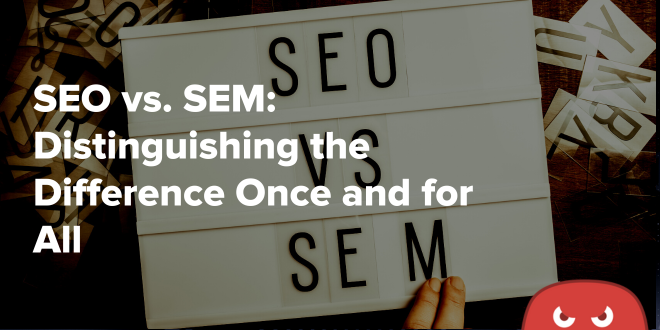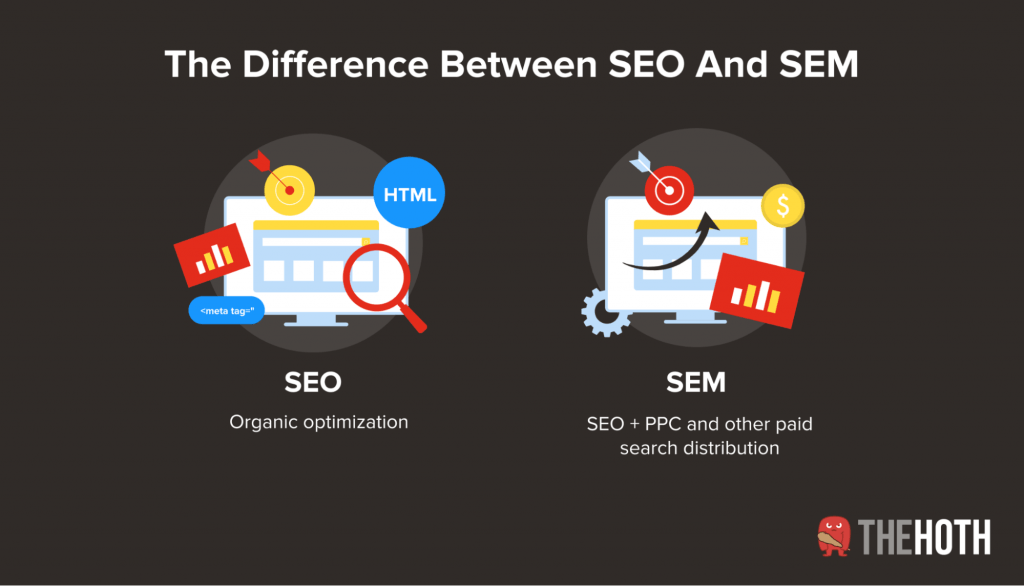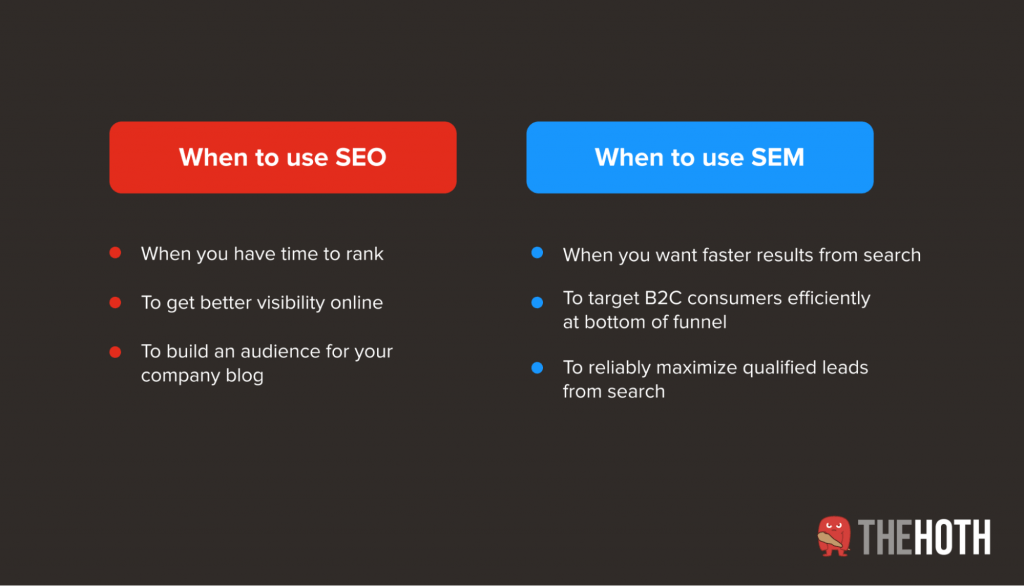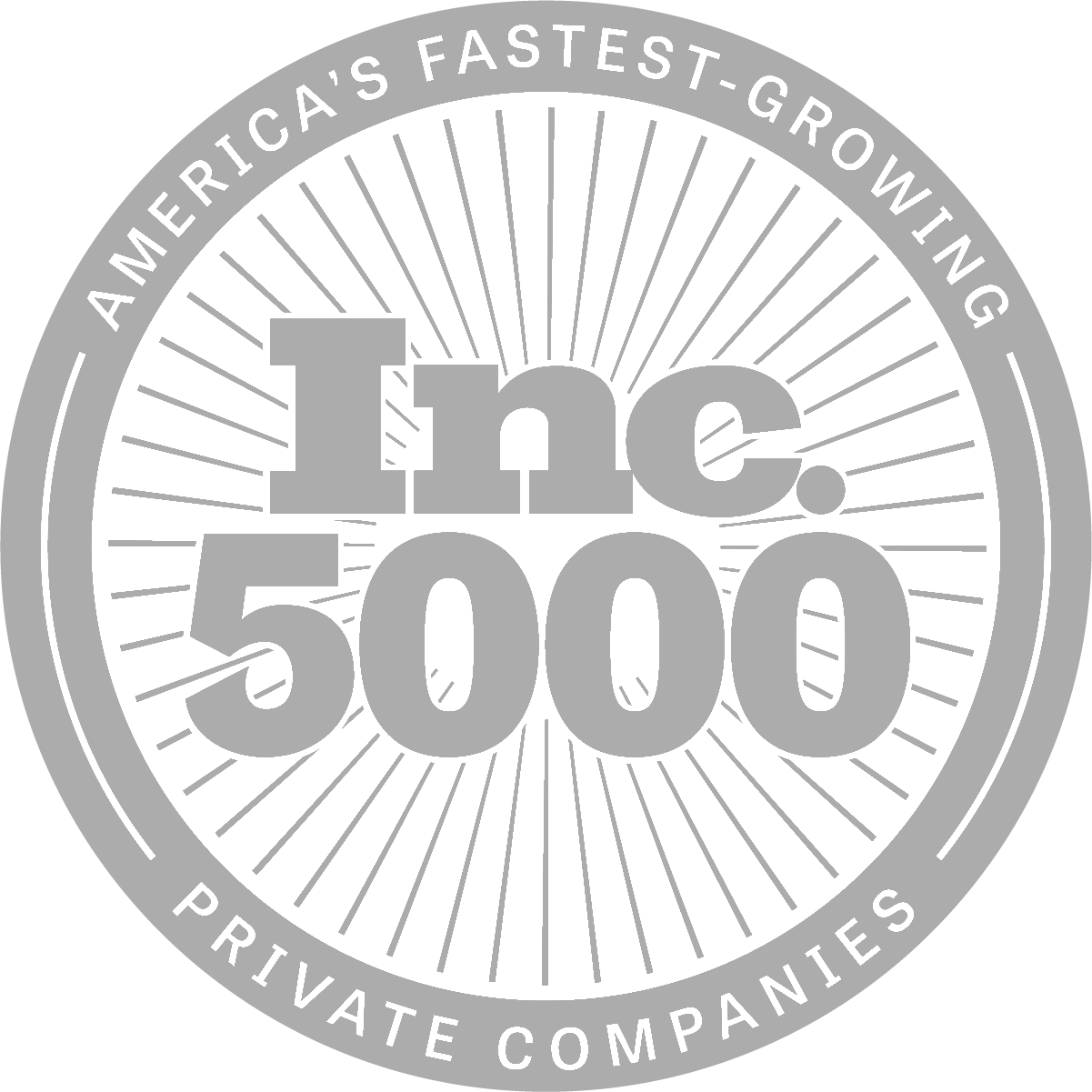Quick Links
There’s enough confusing jargon in the digital marketing world to warrant a science-fiction-style wiki to explain it all (à la Dune or Star Wars).
In particular, there are enough acronyms to make an author like Frank Herbert’s head spin – such as PPC, CPC, CTR, CRM, KPI, CTA, and the list goes on and on.
However, these pale in comparison to the confusion surrounding two deceptively similar acronyms: SEO and SEM.
In fact, most digital marketers assume there is no difference and use the terms interchangeably.
After all, both terms refer to marketing your business through search engines, which is why most assume they mean the same thing.
This isn’t true, as search engine optimization (SEO) and search engine marketing (SEM) are two distinct terms, and knowing the difference is crucial for the sake of your business.
If you don’t do any research beforehand, you may wind up making the wrong choice.
For example, B2B companies benefit the most from organic SEO due to the high ROIs they see from it (with a super high average of 702%).
If a new B2B company assumes SEM is the same as SEO, it may wind up wasting money on paid ads that don’t yield as impressive results.
That’s why it’s imperative to know whether SEO or SEM is right for your business, so stay tuned to learn the key differences between the two.
How SEO and SEM Differ: The Search Engine ‘Umbrella’ Category
Google’s search results are divided into two sections, paid results (sponsored ads) and organic search results.
Here’s a simple breakdown of the difference:
- Paid ads appear at the top of the SERP (search engine results page) for specific search queries. Companies bid on ad placements for search queries relevant to their business (such as a local bakery ad appearing for the query ‘fresh bread in St. Petersburg’).
- Organic search results appear beneath the paid ads (and the AI Snapshot when SGE goes live). These results are what Google’s algorithm feels are most relevant to the user’s query. Websites that have quality content and contain premium backlinks are most likely to rank in the top results.
Search engine optimization (SEO) refers to modifying your website’s content in order to rank higher in the organic search results.
It does NOT involve paid search campaigns, as SEO doesn’t involve paying for SERP placements. Instead, rankings are ‘earned’ through creating high-quality content that follows SEO best practices (like proper keyword placement and fast loading speed).
Search engine marketing (SEM) refers to any marketing tactic that involves search engines, which includes organic SEO and pay-per-click (PPC) advertising.
Therefore, SEO is a subsidiary of SEM.
That’s because SEM is an umbrella term that encompasses both SEO and PPC.
SEO, on the other hand, is 100% about ranking higher in the organic results (and appearing in SGE’s AI Snapshot as a cited reference, but more on this in a bit).
What are the differences between SEO and SEM campaigns?
Now that you know the primary difference between SEO and SEM, it’s time to learn why some businesses prefer using one over the other.
As mentioned in the intro, many B2B businesses focus solely on SEO campaigns due to the higher ROIs they yield.
Why is that, though?
Since SEM also encompasses paid search options, an SEM campaign involves spending money on ad auctions through platforms like Google Ads and Microsoft Advertising.
That means companies that engage in SEM campaigns need to allocate a budget to spend on PPC ads, which is a luxury some smaller businesses won’t have.
It’s for this reason that smaller businesses and websites prefer focusing on organic SEO, as SEO campaigns are far less expensive. In fact, if you have staff available to focus on content creation and link-building, you can run a small SEO campaign entirely in-house.
Another perk of organic SEO is the results you yield don’t cost a dime to maintain.
Once your organic rankings are where you want them (i.e., in the top 5 for your most important keywords), your SEO efforts will continue to supply you with traffic that you can convert into leads and sales.
Paid search ads, on the other hand, disappear as soon as you stop paying for them. That means if your budget fizzles out, all the traffic you’ve been generating from PPC ads will go bye-bye.
The primary benefits of paid search are A) how fast they show results, and B) the amount of control you have over your ads (platforms like Google Ads allow you to display ads at specific times of the day, to specific demographics, and more).
SEO 101: Learning the Components of Search Engine Optimization
To summarize what we’ve learned so far, organic SEO is a branch of SEM that focuses on improving your organic search engine rankings – which appear beneath the sponsored ads on Google’s SERPs.
However, SGE is about to see widespread adoption this year, and the organic search results are about to take a hit.
Google’s Search Generative Experience (SGE) makes use of generative AI to provide direct answers to user queries through ‘Snapshots’ that appear at the top of the SERPs.
As a result, organic results are going to appear further down the page, which will cause an approximate 25% drop-off in traffic for the top-ranked results.
The good news is two-fold.
First, not every keyword will trigger an AI Snapshot, in which case the organic results will appear in the same place as always.
Second, if you’re already optimized and ranking in the #1 or #2 spot in the organic results, you’re far more likely to appear in AI Snapshots for relevant keywords.
Besides SGE, there are quite a few components involved in organic SEO, so let’s take a quick look at each one.
On-page SEO, off-page SEO, and technical SEO factors
Google’s algorithm is anything but simple, as it uses approximately 200 ranking factors when determining the order of the search results for any given keyword.
So, if you want to rank in the #1 spot for a super important keyword related to your business, your content needs to fall in line with Google’s ranking factors.
Digital marketers have devised three categories that encompass some of Google’s most important ranking factors, which are on-page SEO, off-page SEO, and technical SEO.
On-page SEO
On-page SEO refers to all the factors that affect your online visibility that occur on the front-facing side of your website (not behind the scenes).
These include things like:
- The quality and relevance of your content
- Formatting (readability, scannable headlines, etc.)
- Keyword placement (first 100 words, H1 and title tag, image alt text, etc.)
- Metadata (title tag and meta description optimized and containing keywords)
- Schema markup (structured data that qualifies for rich snippets like knowledge bars)
- Internal and external links
Getting your on-page SEO factors in order is a crucial beginning step for any successful campaign, and it’s something we do directly after an SEO audit.
Off-page SEO
Google doesn’t just look at ranking factors that occur on your website, though. There are also certain off-page factors that affect your search rankings, and it’s imperative not to forget about them.
For example, if you sell products or services through your website, the quality of your third-party reviews is a strong off-page SEO factor.
If you have nothing but abysmal online reviews, Google will take notice, and your SERP rankings will reflect this (which means they won’t be great).
Integral off-page SEO factors include the following:
- Reviews and brand mentions
- Backlinks (sites that link back to your content)
- Social signals (the quality and reliability of your social media profiles)
- Guest posts you’ve written
- Press releases and syndicated articles
- The anchor text ratio you use for your backlinks
As you can see, there are quite a few factors to keep track of that don’t occur on your website, so bear that in mind.
Technical SEO
Lastly, Google’s algorithm takes a look at many technical SEO factors that occur behind the scenes of your website.
Since Google wants to present users with the highest quality and most relevant search results, they only want to list websites that run flawlessly.
If your website loads at a snail’s pace and is filled with broken links, don’t expect to rank very high on Google’s SERPs.
The most important technical SEO factors include:
- Proper loading speeds that pass Google’s Core Web Vitals test
- Fixing broken links and 404 Not Found pages
- Duplicate content
- Canonical and noindex tags
- URL structure
- SSL and HTTPS
- XML sitemaps and robots.txt files
If you aren’t too savvy with web development, technical SEO can quickly become confusing and cumbersome, which is why we offer comprehensive technical SEO audits.
A link to the past: SEO link-building
One of the most important aspects of SEO is building backlinks, which are links that point back to your web pages.
Why are backlinks so important?
They are because backlinks are how Google judges the quality, trustworthiness, and authoritativeness of your website’s content.
Akin to an academic citation, backlinks serve as credibility votes for your web pages.
The more backlinks you have from high-quality websites that Google already trusts, the more likely your content is to rank in the top 5.
Backlinks are especially important in the age of SGE, as Google will only list trusted websites in its AI Snapshots.
Link-building is also one of the most challenging and time-consuming aspects of organic SEO.
You can’t just target any website for a backlink, as the site must be relevant and relate to your content in some way.
Besides that, you need to acquire links from trusted websites, as some links will do more harm than good, such as a link from a spam site that provides no value to users.
A website’s domain authority (DA) score represents how likely it is to rank high on the SERPs, so checking the DA score for a link before conducting outreach is standard practice.
Link-building can also be a numbers game if you’re far behind your competitors.
For instance, if a site outranking you has thousands of links while you only have hundreds, you’ll have lots of catching up to do.
It also takes an existing infrastructure to build links properly, which is why so many clients turn to us for things like backlink outreach and article syndication (we have one of the largest link networks on the internet).
SEM School: Integrating SEO with PPC and Other Paid Search Methods
Next, let’s examine the main components of SEM, which include organic SEO and PPC campaigns.
We’ve already covered SEO, so let’s focus on paid search.
The most common paid search method is to bid on pay-per-click ads on search engines like Google and Bing.
This tactic works by bidding for ad spots tied to specific keywords.
As a site owner, you have to conduct keyword research to uncover the most important user queries related to your products and services.
From there, you set your maximum cost-per-click (CPC), which represents how much you’re willing to pay for each click on your ad.
Bear in mind that a click on your ad doesn’t mean a conversion will take place, so you’ll need airtight CRO (conversion rate optimization).
PPC ads will also see changes from SGE’s adoption, but sponsored ads will still play a significant role in Google Search. Some paid ads will appear in the AI Snapshot, and they’ll remain at the top of the SERPs for queries with no Snapshot.
Besides Google Ads and Microsoft Advertising, you can also pay for banner ads that appear on search engines, which also counts as a form of SEM.
These tend to be retargeting ads that appear on third-party sites after users search for your products or visit your website.
The Verdict: Is SEO or SEM Right for Your Business?
By now, you should have a solid grasp of how SEO and SEM differ, but which should you choose for your website?
Here are the most critical factors to help make the decision easier:
- If you’re desperate to see results quickly, you should opt for an SEM campaign that uses both PPC and SEO. Once your SEO efforts gain traction, you can determine whether to stop or continue your paid search efforts.
- Smaller websites and businesses tend to have tighter budgets, in which case SEO reigns supreme. It’s cost-effective and has a compounding effect, meaning the traffic keeps rolling in long after you’ve created the content and done the optimizing.
In the age of generative AI and Google’s SGE, we feel that organic SEO paired with strong link-building practices will yield the most robust results for marketing your business through search engines.
If you want to meet your marketing goals this year, don’t wait to check out HOTH X, our top-tier managed SEO service (including a plan to thrive during the age of AI).













Excellent article about SEO and SEM. It is very informative. Thank you for taking the time to differentiate between SEO and SEM. The article is helpful.